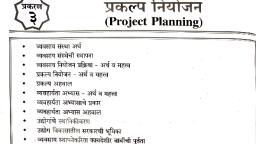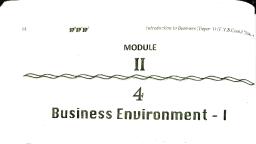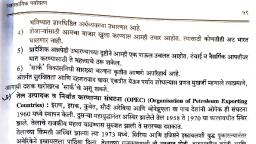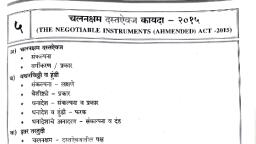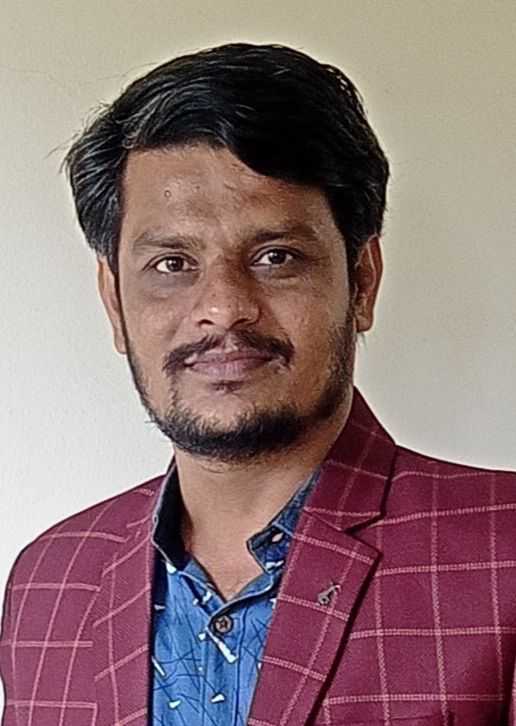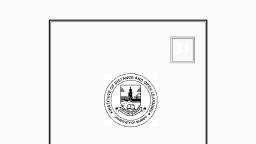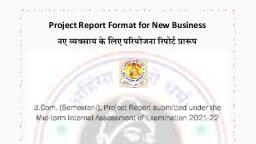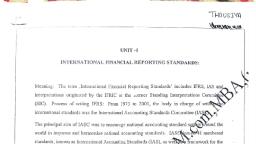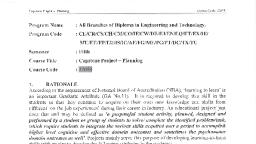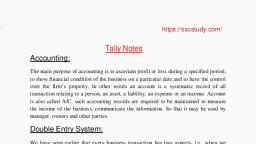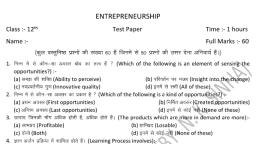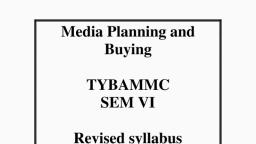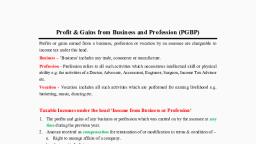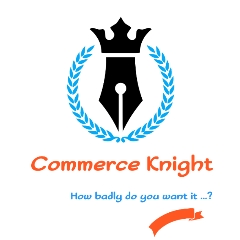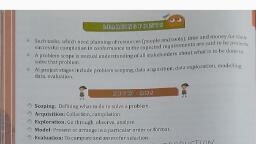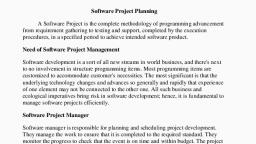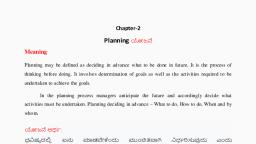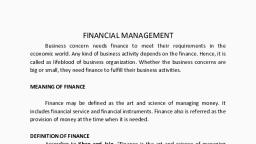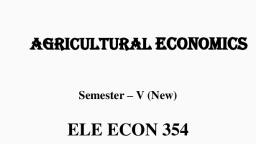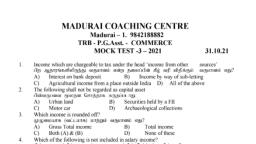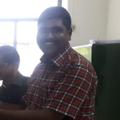Page 1 :
71, , M ODULE, , III, , 6, Proje ct Planning, , SYNOPSIS, ❖, , ❖, , ❖, , ❖, , Business planning process, •, , Meaning, , •, , Steps, , Project planning, •, , Importance, , •, , Project report, , •, , Types, , •, , hnportance, , Feasibility study, •, , Types, , •, , Importance, , Feasibility report, , Free!!!, , ~uestions and Answers available with scratch card provided in the book. Please follow, instru r, c ions provided for downloading
Page 3 :
IntroductioH to Business (Paper- I) (F. Y.B .Coni.) (S, , 74, , 1., , Achievement of goals, , ., , e,,,., f), , ., , ., ., f' d b'ectives., planning 1s required t0 f, Everv1 pro1ect has certain, well de me O J · • Proper, ·, •, •, ocll, ., ., •, •, on the objectives set. Pro1ect planning gives d 1·rect10n and gm dance m order to ac1i.:ueves, these., 2., , Clarifies Action, • clearly defmes, ·, ., Project planrnnot h e ac t·ions to be taken for completion, h of the pro]eq, 0, ., h, ·, t, ·, clear, about, the, w, ork, e, or, she, h, Hence, each person workmg on t e pro1ec is, as to·, perform in the organisation., Provides Project Details, It o-ives detailed information of every task i.e. who should do th e assignment, what, task sh~uld be prioritized, when should the task be accomplished and so on. This helps in, better performance of the task., 4., Specifies Time, Project planning involves scheduling of the project. It estimates the time ~e~uired for, completion of the project. It specifies the time required for each and every activity related, to the project. This helps in time management., 5., Cost Involved, Project planning involves making a financial plan for the project. This gives an idea, about the expenses i_n volved in the project. The management therefore gets an insight, about the fixed and working capital requirements for implement_ing the project., 6. Identifies Risk, Due to project planning, it is possible to -identify possible risks during the course of, the project. This enables ih making alternative plans for contingencies. By having such, plans ready, risks can be minimized., 7. · Avoids Wastage, 3., , Project planning helps to avoid duplication of resources, tasks and labour by giving, everyone a clear idea of their respective role in the project. Since each person working on, the project is clear about the work assigned, the resources allocated, time required etc for, completing the project, wastages can be minimized., 8., Specifies Quality, . It gives a clear d~tail on the standards of the projects and what is expected from the, pro1ect through quality management plan. Hence people working down the hierarchy, become aware of the standard expected about the product and their performance., 9. Provides guidance, , f, , !, , Project planning enables in assigning appropriate roles to people. It also guides, people and thereby expedites work., , I PROJECT REPORT, , ----1, ~, ~, =, ;, ~, -----_.), MEANING, , IItI, I, I, , A ~roje_ct is an_ i~ea or plan that is intended to be carried out. The dictionary meaning, of a pr?Ject 1s that 1~ 1s ~ scheme, design; a proposal of something intended or devised to, be_ a~h1eved. A proJe~t is prepared for setting up a new business unit or for expanding the, , ex1stmg one. The basic three attributes~£ the project are :, • A course of action, • Specific objectives _, • Definite time .perspective
Page 5 :
76, , s,®5p®5t', , •, •, , Introduction to Business (Paper- I) (F. Y.B.Com.) (Sen,.,, , ., . ., IJ, k 111, · vestrnent decisions i.e. to decide whether, It is useful for the investors to ta e, or, not to invest in such a proposed project., ., ., d, ·, ent on hire-purcha se or credit basis i ., The suppliers of ma~hmery an e~mpm the soundness of the proposed pro·nsist, on the project report m order to a fmd out, Ject., , ~,F~E~A~S~ IB~I~L~IT~ Y~S~T~U~ D-!_Y~----- --- - -- - - - - - - - ~, MEANING, , ·, l ·1·, Feasibility study of a project refers to finding out the practicfa huh it~ or tbhe future, . an uupartia, •, · I an d a sci·entific study o t e proJect efore 't, prospects of a project. It 1s, . .., 1s, ·, ·, · an analysis, · of th e via, · b·1·t, study, focuses, 0, final, selection., It 1s, i i Y o f a ProJ·ect · The feasibility, ., n, II h, ., ., •, f, ld, we, proceed, with, the, proposed, proi·ect, helpmg ansvler the essential quest10n o s ou, idea?", ·, Thus, feasibility study is an analysis and evaluation of a proposed project to, determine if it is:, • Technically feasible, • Within the estimated cost, • Profitable, Such a study is undertaken by experts. It may be undertaken independen tly by banks, or financial institutions. Even the government agency may conduct feasibility study before, grantin.g licence, permission or financial assistance to a new project. Feasibility ~tudy_ is, necessary and useful ~specially in case of large projects which need huge finanCial, inveshnent. The basic purpose of feasibility study is to find out whether the project is, technically, economicall y, financially and manageriall y sound. Although every feasibility, analysis is differt=nt and is tailored to suit the product, its goal is to identify the strengths, and weakness_es of the project. Feasibility study is a lengthy process., , I TYPES/AREAS OF FEASIBILIT Y STUDY, 1., , ], , Technical feasibility study, , It covers the technical aspects of the proposed project. The purpose of studying, te~hnical aspects is to find out whether or not the project is technically sound. It covers, technical aspects of the project such as location, size, layout and techn.ologtj, It also, covers certain other basic requirement s of the project such as water supply, fuel, transport,, waste supply, raw materials etc. are also covered in this study . Following are some of the, technical aspects :, , • Technology and manufactur ing process: Type of technology, basis of selection of, technology, competing technologies , performanc e data of plants based on the technology,, details of licensor of technology, process flo w chart and description., • -~o_cati?n of the Projec~ ~ ~ocational advantage, availability of raw material and, other uhhhes, infrastructu re fac1hhes and availability of labour., ·, • Plant and Machinery : List of machinery & equipment, details of suppliers,, competitive quotations, technical & commercial evaluation of major equipment., • Raw material, Utilities -and Manpower : Details of raw materials and suppliers,, electricit~ and wa ter supply, basis of manpower estimates, details of manpower e.g., managerial, supervisory , skilled/ unskilled, training n eeds, • Contracts : Agreement with contractors detailing on know-how, engineering,, procuremen t, construction , financial soundness and experience of contractors, ~ ~roject moni~oring and_implementa tion : Mode of implementa tion, detail:-: lit, momtormg team, detailed schedule of implementa tion.
Page 6 :
NJarket feas1b111ty stucty, , z, This feasibility study covers the marlcet 11 0 ,., , •, , C'ntrafs 0 .f l:he product. lL in cludes a study, , of:, •, , Existing and potenti al market dema d, ., n and ~supply f or ti 1e propose d pro d uct m, respect ot- vo 1ume and pattern, , ., Share of the proposed product of tl1, e company, • n,arketing strategy, · 1n tl1e to t a I mar k e t tl1roug h, ,, ,, , t· ·t, product and export pote-n1a,1, Selling price of .the, 1 any, ., Market competition, , ,, ,, , Substitutes available, Charn1els of distribution, , ,, , Prospects of grm.v th etc, , 3. Commercial/financial feasibility study, , It _relates. t~ _the finan~ial aspects of the project. The basic purpose of conducting, st~dy is to find out the profitability of the project. Various aspects, -~11a11cia~ fea~zbzltty, covered m this study are:, i) Cost ~f the Proje~t : This includes the cost of land & site development, building,, plant & machmery, teclm1cal know-how & engineering fees, miscellaneous fixed assets,, preliminary & preoperative expenses, contingencies, margin money for w orking capital, etc., ii) Means of Financing : It includes share capital, promoter's share in equity share, capital, unsecured loans from promoters/ associates, internal accruals, term · loans,, Government subsidy/ grant etc., iii) Profitability Projections : This covers profitability estimates, projected cash flow, and Balance Sheet for the project and for the Company as a whole. Based on the, projections, various financial ratios such as Debt -Equity ratio, Current ratio, Fixed asset, coverage ratio, Gross profit, Operating profit, Net profit ratios, Internal rate of retum(over, the economic life of the project), Debt Service Coverage ratio, Earning per share, Dividend, payable etc. are worked out to ascertain financial soundness of the project., 4. Management feasibility study : This covers aspects such as:, , Background and industrial experience of promoters, • Broad composition of the Board, • Details of full time directors and their responsibilities, • Details of chief executive and functional executives, , •, , • Organizational chart, • Proposed Salary and Benefits to employees, • Personnel policies such as promotion, training, incentives etc., 5, · Environmental feasibility study, It is undertaken to find out the environmental impact of the proposed project. It, covers aspects such as, , • Statutory compliance or concerns related to environment, • List of pollutants / Hazardous substances, their safety, handling and disposal, arrangements, • Compliance w ith national and International Standards, • Clearances and N O objection. certificates required and obtained etc.
Page 8 :
~ OF BUSINESS UNIT PRflOll\MMO=vTn1~o~N; -- --, , - -- - -- --, , -, , .,, , simple words, promotion of a busine, ., ., 111 . tence. The process of conceivin, ~~ urnt mean_s th e steps undertaken to bring it, into ex1~ncrete reality through incorpor!ti:~ I. ea of startm.g ~ comp.any and_ developing -it, into a~, and refers to the sun1 total of t is call~~ pr01notion. It JS the pnmary stage of, formation, hose activities related to setting up of business, , ~11its., , ., romotion of a business, . . . t h at are require, • d, . J unit can be stated as "a ll th ose activities, P, bl, t, t, derta, en, o, es, a, is, 1, a, new, busii·, i, e, ·t, 1, ., •, ·, ·, k, to be u11, ., ., ss uni 1 or manufacturing or distribution, o1·, roduct or ptovide any service to the people ", 111y P, •, •, rts, with, conceiving, an, idea, of, b, ·, · an opportunity, · for d01ng, ·, s, ., ., ., ., us1ness, or d'1scovenng, ta, It, i business, a_ssess its f~asibiht~ a~1d then take the necessary steps to launch the business, ut. Promotion of busin~ss units is undertaken by pr01noters. A promotet is a person who, 11, fevises a p~an for a business _venture; one who takes the preliminary steps necessary fo r, he forma tion of a c~rpora t1on. Promoters are the people, who, for themselves or on, ,ehalf of others, orgarnze a corporation., ·, , 'ROCEDURE IN SETTING UP A BUSINESS UNIT, , 'he procedure of setting up of new business enterprise is very lengthy and time, onsuming. It includes many steps and formalities . These are explained as under:, , . Discover a business opportunity, The id.ea of starting the business enterprise is conceived by the promoter. The, Jromoter first finds out a business opportunity. He can gather ideas through research,, narket surveys, consultation with advisors, observation at market place and so on., , i business opportunity may be to :, , • Start a new business,, • Expand or diversify the existing one, • Purchase another co1npany,, • Enter a joint venture or foreign collaboration, etc., 1, Preliminary Investigation, At this stage the soundness of the business is studied by the promoter. The promoter, nakes a rough estimate of probable incomes and expenditures of the business unit to be, ,tarted. He also makes an assessment about business risks, financial risks, investn1ent, :isks, technical risks and commercial risks of the venture. In other words, the viability, 1nd profitability of the project is studied., ). Size and form of business, The prom.oter has to decide about the size and forn1 of the business unit. He has to, decide whether the business unit w ill be a small, medium-one or large size. He n1ust, de~ide whether it should take the form of a proprietary firm, partnership firm, public or, ~:lV~te limited cmnpany etc. The decision depends on many factors such as capital, quired, econ01nics of scale tax extent of liability and so on., 4. L, ., ', ', ocation of business, ., of thDeciding suitable location is an important step in setting up of a business unit.'Some, · e factors taken into account w hile deciding the location are:, 1, Easy availability of raw materials, 1, Nearness to market, 1, Availability of infrastructure facilities like roads, power, warehousing etc., I, , Banl< ino-, , f ,,.,..~1;+.; ,-v,
Page 9 :
' 115·, 0, ~', , 1, , ·, F.S DETERMINING LOCATION OF BU SINESS UN IT, f, ·, fd · ., ,.vith the probl . ., fAcfOerYentrep reneur ·is faced, cm ° CCJdmg the best site for location o, ·, . f., ., f a, ., h, . ., of 1.eg1on, £V iness. Business. location bre. ers, an d t e se 1ect10n o, ··, . to the choice, . 1na d e on1y. a fter, . 1s, But. the ch. 01ce, or factory, uf. p a f dus1ness, for setting, ·s btls, . ·, .ff ., ., ar s1·te, \11 • 1, . one w h ere, sites • A11,. . 1·d ca 1. 1oca t·10n JS, alternative, its o 1. •. erent, ', ., •, ., ·dering Costs and bene, r,·ruct1, w ith .a large market share, the ]east risk and, ro051 t of the pr~duct ~s kep_t to lTIJnunuin, _, 05, th e place which gives lowest unit cost of productjon and, 1he c axirnum social gain. It IS, 1, 1, 11ie ~ . 11 . S01ne of the factors that govern location are explained as under :, ., ·~tnbt1tt0, 1, 1, , bility of raw materials, •, Aval1a, 1, · R v material fonn major proportion of the finished product. Unrestricted and, . 1., ~, raw matena Is necessary for carrying out continuous production., of, supply, I, · 1·, f, etruar, r O • ess to the source o raw Inatena IS very economical for an industrial unit. Hence, ., ., ., ., ~~ n, , industries have been set up near the source of su pply of raw material. For instance,, ·, 11, ~ : )r factories in Uttar Pradesh, textile units in Mah arashtra and Gujarat, cement factories, ~~~adhya Pradesh_and jute industry in W est-Bengal. Only nearness of raw materials is, at sufficient; it must also be easily accessible. Adequate transportation facilities should be, ·, :vailable for carrying the Inaterial from th e source of supply ., tl •, , 2. Nearness, , to market, , Market greatly affects the establish1nent of an industrial unit and is in fact, dominant, factor in locating an industrial unit in modern times. Every business unit dep ends on a, market for selling its goods and services. The goods· ·a nd services must reach the market, ontime, and it must be available to the consumers at a low price. N earness to market also, helps in reducing cost of transporting finished goods. It is possible to make goods, available at the right time. It · enables to render quick service an d after sale service ., Nearness to market is preferred when the p roduct is fragile, p erishable, bulky or when, quick service is required., 3. Availability of infrastructure facilities, Availability of infrastructure facilities like pow er, w ater, t ransport & co1nn1.unicati on,, ~anking facilities etc. are important determinants for business location. Unavailabilit y or, irregular supply or shortage of · above factors could adv ersely affect the p roduction, process., 4, ' Availability ~£ transport an d communicati on facilities, , ra Adequate and quick facilities of tran sport Inust be kept in n1.in d for quick delivery of, · the life, · n IS, · 1s to the factory and finished p roducts to t h e 1narket. Transportatio, linewlltatena, alreai lhodern industry . An industry should b e located in the areas where there are, indus{riadevelope ~ means of tran sportation. Farida~ad in H aryan a d evel~ped as an, 1, town on a ccount of availability of both rail and road transportation . Certain

